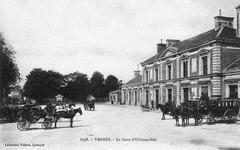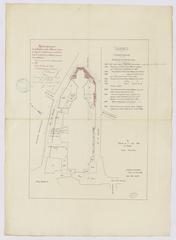Chapelle du Château de Meudon: Visiting Hours, Tickets, and Guide to Vannes Historical Sites
Date: 14/06/2025
Introduction
The Chapelle du Château de Meudon, whether referenced in its grand Parisian context or its Breton counterpart in Vannes, is a monument steeped in centuries of French aristocratic, religious, and architectural history. Both chapels—though distinct in location and heritage—offer a window into the evolution of French noble estates, the interplay of faith and power, and the enduring legacy of architectural innovation. This guide provides a detailed exploration of their histories, practical visitor information, and tips to enrich your experience at these remarkable sites.
Table of Contents
- Meudon (Paris): History and Visiting Guide
- Vannes: The Breton Château de Meudon
- Chapelle Saint-Georges, Potager du Dauphin (Meudon)
- Summary and Visitor Recommendations
- Sources and Further Reading
Meudon (Paris): History and Visiting Guide
Origins and Early History
The Meudon estate near Paris traces its lineage to the medieval period, with the earliest records from the 12th and 14th centuries. Initially a feudal manor, it passed through the hands of influential lords, including Robert de Meudon, Grand Panetier of France (Wikipedia: Château de Meudon). While the original chapel’s exact plan is lost, a place of worship almost certainly existed from the estate’s beginnings, serving the lords and their households.
Renaissance and Baroque Flourish
The 16th and 17th centuries marked the estate’s transformation into a Renaissance and then Baroque masterpiece. Under Anne de Pisseleu d’Heilly, Duchess of Étampes, and later the Marquis de Louvois, the château was enhanced by architects like Louis Le Vau. The chapel became the setting for major dynastic events, such as the 1643 renewal of the marriage between Gaston d’Orléans and Marguerite of Lorraine (Wikipedia: Château de Meudon). Later, the Grand Dauphin’s residency elevated the estate’s ceremonial and religious significance, with the chapel adorned by Gobelins tapestries and Baroque art.
Revolution and Modern Transformations
The French Revolution marked a turning point: the estate was nationalized, and a fire in 1795 devastated the main château, including the chapel (Wikipedia: Château de Meudon). The Château-Vieux was demolished in 1803. Surviving structures, including the Château-Neuf, were later repurposed as the Observatoire de Meudon, now part of the Paris Observatory (France Voyage).
Visiting Hours, Tickets, and Accessibility
- Opening Hours: The Meudon estate grounds are usually open Tuesday to Sunday, 10:00 AM–6:00 PM; closed Mondays and public holidays. Always check the official website for updates.
- Tickets: General entry to estate grounds is free. Special exhibitions or guided tours may require a ticket, available online or at the visitor center.
- Accessibility: Gardens and main visitor facilities are mostly wheelchair accessible, but some historic terrain may be uneven. Contact staff in advance for assistance.
- Guided Tours: Regular tours focus on the estate’s history, including the chapel’s legacy. Events, concerts, and educational programs occur seasonally.
- Nearby Attractions: Parc de Saint-Cloud, the Paris Observatory, Meudon town center, and local markets are all within easy reach.
Notable Events and Cultural Legacy
The chapel played host to royal ceremonies, masses attended by the court, and the artistic elite. Artists like Nicolas Poussin visited, and the estate’s integration of gardens and architecture exemplifies French classical design (Wikipedia: Château de Meudon).
Frequently Asked Questions (FAQ)
- What are the visiting hours?
Tuesday–Sunday, 10:00 AM–6:00 PM; closed Mondays and holidays. - Is there an entry fee?
General access is free; some tours/events may require a ticket. - Are guided tours available?
Yes, book in advance for detailed historical tours. - Is the site accessible?
Partially; some terrain may be challenging for those with reduced mobility. - How do I get there from Paris?
By train or bus; the estate is easily accessible via public transit.
Vannes: The Breton Château de Meudon
Historical Context and Architecture
In Vannes, Brittany, the Château de Meudon estate dates to the medieval era, with the current Neo-Renaissance château built in 1847 by Edmond de Lantivy du Rest on the site of a 15th-century manor (POP: Plateforme ouverte du patrimoine). The chapel, although privately owned and closed to public visits, is a striking feature of the estate’s H-shaped design, and the park retains the ruins of the original manor (France Voyage).
Architectural Highlights:
- Neo-Renaissance symmetry, stonework, and potential stained glass.
- Integration with landscaped park and medieval ruins.
Visitor Information and Nearby Attractions
- Access: The château and chapel are private; interior visits are not permitted. Visitors may view the estate from the exterior and explore the park.
- Nearby Sites: Vannes’ medieval ramparts, timber-framed houses, Saint-Pierre Cathedral, and Musée de la Cohue provide a rich historical context (Solo Sophie).
- Tips: Visit during daylight for the best experience; the site may be less accessible to those with limited mobility.
FAQ
- Is the chapel open to the public?
No, but the park and exterior can be viewed. - Are guided tours available?
Not at present due to private ownership. - When is the best time to visit?
Spring and summer daylight hours.
Chapelle Saint-Georges, Potager du Dauphin (Meudon)
Artistic Features and Visiting Details
Located within the Potager du Dauphin, the Chapelle Saint-Georges is an early 20th-century chapel notable for its painted décor by Father Igor Sendler, blending Eastern Orthodox and Western Christian iconography (Guide Tourisme France). The chapel is open during special events, such as Heritage Days, or by prior arrangement.
- Admission: Free during events; donations welcome.
- Accessibility: Contact the administration in advance for accessibility information.
- Guided Tours: Occasionally available during public events.
- How to Visit: Use Transilien line N or RER C to Meudon/Meudon-Val-Fleury, then walk to the Potager du Dauphin.
Nearby Sites in Meudon
- Château de Meudon Ruins
- Observatoire de Meudon
- Meudon Forest
- Musée d’Art et d’Histoire de Meudon
Summary and Visitor Recommendations
The Chapelle du Château de Meudon—both in Paris and Vannes—offers a rich journey through France’s aristocratic, religious, and architectural history. In Meudon, visitors can explore the estate’s gardens, enjoy guided tours highlighting the chapel’s lost grandeur, and experience local events and cultural heritage. In Vannes, while interior access is restricted, the château and its park remain a testament to Brittany’s noble past.
To make the most of your visit:
- Check the latest opening hours and tour schedules on official sites.
- Combine your visit with nearby historical attractions.
- Download the Audiala app for updates, audio guides, and travel tips.
- Respect the solemnity of remaining chapels and estate grounds.
By engaging with these sites, you participate in the ongoing celebration and preservation of French cultural identity.
Sources and Further Reading
This article is based on information and references from:
- Wikipedia: Château de Meudon
- France Voyage: Castle of Meudon
- POP: Plateforme ouverte du patrimoine
- France Voyage: Château de Meudon in Vannes
- Guide Tourisme France: Chapelle Saint-Georges Potager Dauphin Meudon
- Official Meudon Tourism Site
- Observatoire de Paris - Meudon
- Solo Sophie’s guide to Vannes

